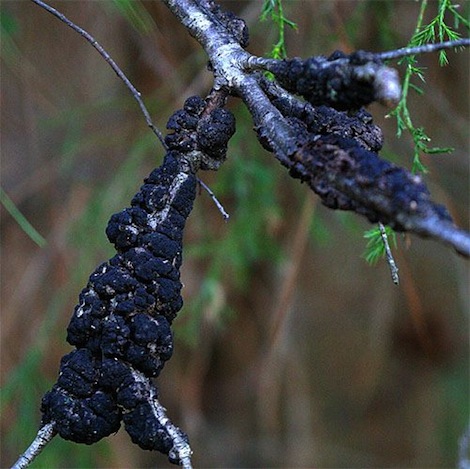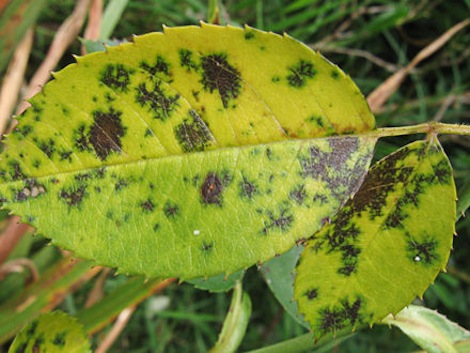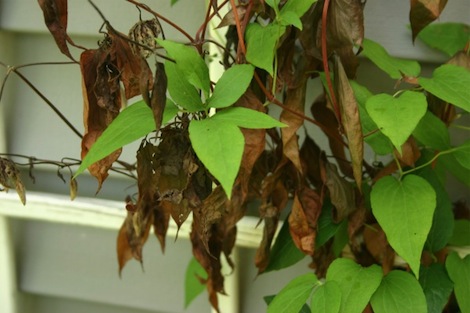
It's the time of year to look for disease in the garden.
Unfortunately, the weather we have been having is the perfect breeding ground for disease.
It is much easier to prevent plant disease than cure it.
If you keep plants healthy with regular fertilizing, space plants and trim so that there is good air flow and clean up any damaged leaves as soon as you notice them, you will be well on your way to a healthy garden.
Some common diseases that you need to watch out for:
* Powdery Mildew is one of the most common leaf diseases. It shows up as a greyish-white film on the leaf surface that can be easily wiped off. It thrives in hot humid or cool damp weather. Prevention is the best cure for this problem. Water early in the day so foliage is not wet overnight. Treat disease prone plants with a spray or dust of Garden Sulphur every week to ten days. Tall garden Phlox, begonias, cucumbers and squash are a few of the plants to watch.
* Black Knot (pictured above) is another common disease that is very easy to spot. Members of the plum family, plus Chokecherry and Pin Cherry are very susceptible. You will see a black bulbous growth of tissue emerge from a crack in the bark of branches or tree trunks. Quick pruning is the only treatment. Cut the limb off 12 inches below the diseased area, bag the branch and get it off your property. Dip you pruning tools in Rubbing Alcohol after each cut so that you don’t spread the disease around. After pruning, spray the plant with a fungicide containing copper sulphate. If you have Black Knot in the trunk of a tree, unfortunately it must be cut down.
* Black Spot is a common leaf disease. Many roses are prone to it. A black sooty spot appears on the leaves; the leaf turns yellow and falls off. Using sulphur as a preventative spray is always the best way to combat this problem. In cool, damp weather, keep an eye out for Black Spot on Flowering Crab Apple trees too. These plants have been hit hard the last few years. Watch you watering practices; try to keep foliage dry. Clean up and bag any diseased leaves; don’t put them in the compost pile.

* Clematis Wilt is a disease that can hit suddenly. The fungus is a common one that lives in the soil. When the stem of the plant gets nicked or cracks, the fungus moves in and rapidly multiplies in the tiny tubes that carry water from the roots to the leaves. The tubes get clogged, the water can’t get through and the leaves suddenly wilt and die. Be very careful when cultivating around your clematis. Try not to damage any stems. Make sure the vines have good support so that they don’t crack on a windy day. If disease strikes, cut down and bag all stems and foliage. Look closely at the crown of the plant. If it is still healthy, spray with Copper Sulphate and wait to see if it re-grows.

* Fire Blight is another disease that strikes quickly. It can be spread from tree to tree by pollinating insects. Mountain Ash and pear trees are prone to this disease. Stems will suddenly turn black and leaves look scorched as they quickly die. Prune as mentioned above for Black Knot and remove the tree if the damage gets into the trunk.
* Leaf Blight is a wide group of diseases that show up on many plants. It shows up as irregular dead spots on the leaves. Copper Sulphate is the best product to use for this problem. It is most common on plants that are stressed. Try to keep plants well watered during periods of drought. Use the correct fertilizer for the plants you grow and clean up damaged foliage quickly to prevent the spread of the disease.
This is also the time of year that you will also see an upswing in bug activity in the garden.
Since the ban on all the toxic garden chemicals, you have to be very aware of the individual problems you have and treat each pest with the appropriate product.
If you can't see the insect doing the damage, try going out to the garden after dark with a flashlight to do some sleuthing.
I have something eating the leaves of my eggplants.
I will be out tonight trying to see what bug I have to deal with!